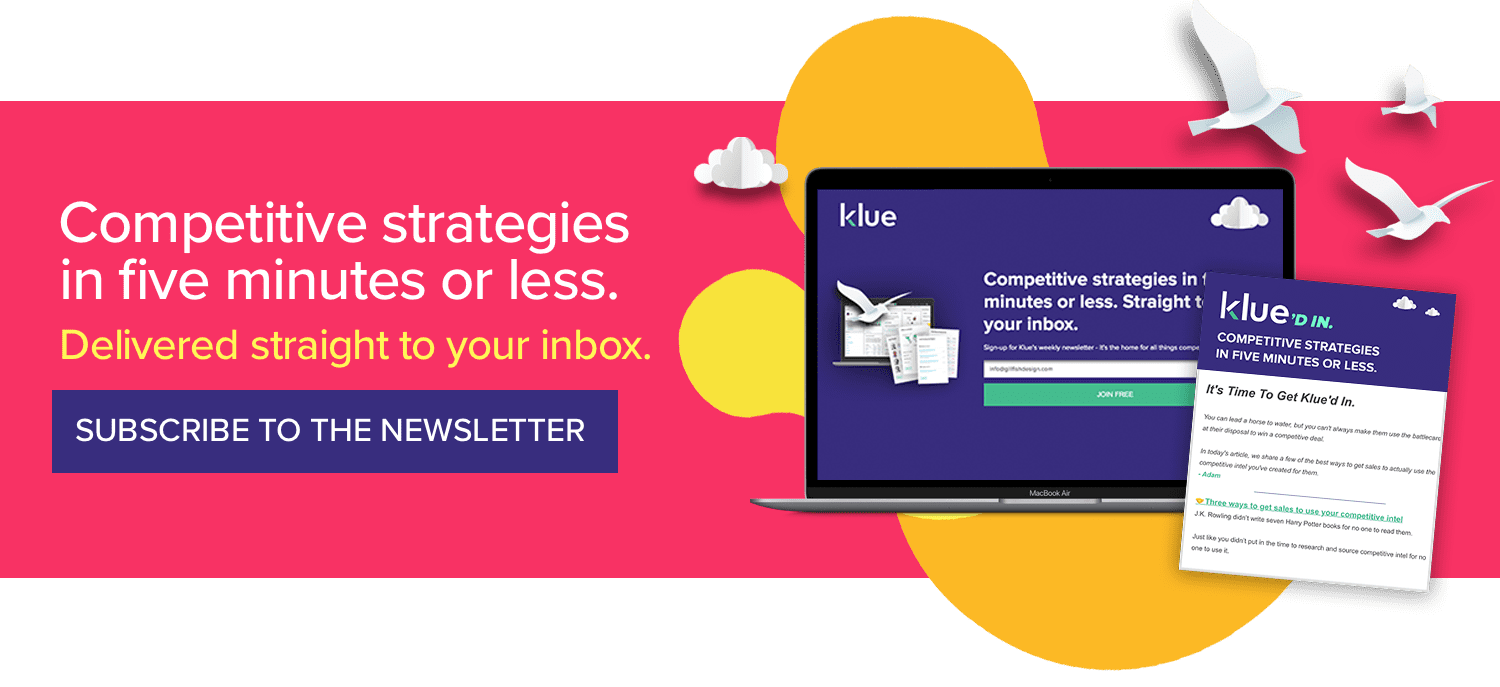Klue Compete
The Competitive Enablement Platform
Learn More
FIND OUT MORE >

This article is an excerpt from our weekly ‘Klue’d In’ newsletter.
If you want to keep up to date with our newest articles, podcasts, interviews, and poorly-worded puns, then come join us.


When you’re the sole person in charge of your organization’s competitive program, it can be a lonely and daunting feeling.
And it’s a feeling that Mark Balkenende, Sr. Director of Product Marketing at Matillion, has experienced on more than one occasion.


In the latest episode of the Competitive Enablement Show, Mark shared the secrets to success that he discovered while building competitive enablement programs at both Matillion and Talend.
An easy way to determine the starting point of your competitive program is by aligning it to the business needs.
“And nine out of ten times, the biggest competitive need will fall on sales,” says Mark.
Sales are coming up against competitors on a daily basis. This means that not only do they have an immediate need for competitive intel, but also offer the clearest window into what your competitors are doing.
Both of these reasons are why Mark says that focusing on sales early provides ‘the biggest bang for your buck.’
Solo compete teams are strapped for resources. Partnering with sales will help you collect competitive intelligence efficiently.
“At both of my competitive programs, I’ve started with the sales team and then answer: what do they need? How do they access it? And how can they share feedback with me?”
Tip #1: Prioritize which teams need competitive intel the most, and who can give you information the fastest.
So you’ve identified an audience — in Mark’s case, it’s sales — now how do you share intel that a) they’ll actually use and b) will help them beat competitors?
Cue the secret sauce to creating the best competitive battlecards:


“First off, stick to the basics. If you get too complex… the sales team won’t digest it.”
Great, your sales rep aren’t freaking out, closing their laptop, and jumping into a cold shower to try and forget that daunting 8-page battlecard anymore. But how do you still put meat on the bone that they can sink their teeth into?
Mark notes that it starts by always addressing the strengths, weaknesses, opportunities, and threats for a competitor. Then provide tangible examples that make your intel applicable and credible.
“Those examples of how you won against competitors, those are our most viewed battlecards… Share the key things that the rep positioned in order to win.”
Now reps are learning from their peers and not just taking your word for it.
Tip #2: Don’t produce all your battlecards at once. Get 60-70% done, include competitor SWOT analysis, and improve from there. BE EFFICIENT.
It’s easy for your competitive program to get overlooked. Don’t let that happen.
“Just the other day my CRO said he didn’t think that anybody in his sales team really used battlecards,” says Mark.
Sales leadership thinking you’re not moving the needle? Gulp.
Luckily, Mark proved otherwise. He had tracked in SFDC and Klue what sellers had been using what battlecards, and how long they’d viewed them for.
Mark’s results showed that their top five sellers were spending a ton of time in the battlecards he’d created.
Mic drop.
Here are a few other ways you can measure your content usage and impact:


“If you can use data it really helps you build the case for more people. At Talend, in less than a year I was able to get headcount.
I was able to justify, ‘if you give me resources, I can build more assets and provide more coverage on competitors’. The program is helping reduce loss rate, improve deal size, and speed to close.”
Tip #3: Use SFDC or a CMS to track what battlecards are used and when.
Catch the full conversation with Mark, where we dive into a whole lot more, on Apple and Spotify.




Competitive Enablement
The topic of Large Language Models (LLMs) has a lot of confusion. Here's what you need to know about how Klue is working with them.


Competitive Enablement
Product Marketing
If your competitive intel game is too strong for automation, too pure for data privacy, and too rebellious for accuracy — then Klue AI is probably not for you.


Let’s do it. Tell us a bit about yourself and we’ll set up a time to wow you.
Let's do it. Tell us a bit about yourself and we'll set up a time to wow you.
XLet's do it. Tell us a bit about yourself and we'll set up a time to wow you.
XSubscribe to get our latest AI functionality and news in your inbox.
XOur Buyer Pulse feature, set to launch in Q2 2024, offers valuable insights into the factors influencing buyer decisions in your pipeline. By signing up for the waitlist, we can better gauge interest and proactively engage with you to streamline the setup and integration process before the feature becomes widely available.
X